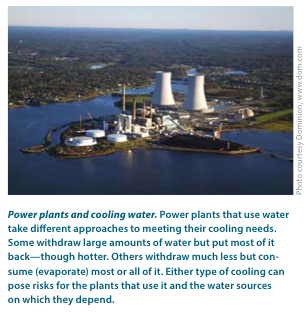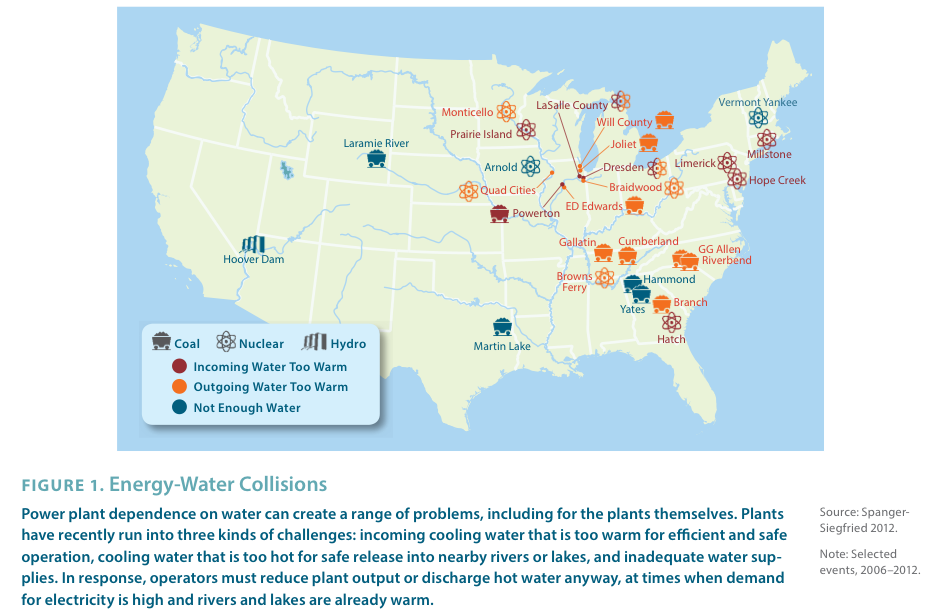UNION OF CONCERNED SCIENTISTS
Executive Summary
The heat waves and drought that hit the United States in 2011 and 2012 shined a harsh light on the vulnerability of the U.S. electricity sector to extreme weather. During the historic 2011 drought in Texas, power plant operators trucked in water from miles away to keep the plants running, and disputes deepened between cities and utilities seeking to construct new water-intensive coal plants. In 2012, heat and drought forced power plants, from the Gallatin coal plant in Tennessee to the Vermont Yankee nu- clear plant on the Connecticut River, to reduce their output or shut down altogether. That summer, amid low water levels and soaring water temperatures, operators of other plants—at least seven coal and nuclear plants in the Midwest alone—received permission to discharge even hotter cooling water, to enable the plants to keep generating. These consecutive summers alone revealed water-related electricity risks across the country.
 The power sector has historically placed large demands on both our air and water. In 2011, electricity generation accounted for one-third of U.S. heat-trapping emissions, the drivers of climate change. Power plants also accounted for more than 40 percent of U.S. freshwater withdrawals in 2005, and are one of the largest “consumers” of freshwater—losing water through evaporation during the cooling process—outside the agricultural sector.
The power sector has historically placed large demands on both our air and water. In 2011, electricity generation accounted for one-third of U.S. heat-trapping emissions, the drivers of climate change. Power plants also accounted for more than 40 percent of U.S. freshwater withdrawals in 2005, and are one of the largest “consumers” of freshwater—losing water through evaporation during the cooling process—outside the agricultural sector.
The electricity system our nation built over the second half of the twentieth century helped fuel the growth of the U.S. economy and improve the quality of life of many Americans. Yet we built that system before fully appreciating the reality and risks of climate change, and before converging pressures created the strain on local water resources we see today in many places. This system clearly cannot meet our needs in a future of growing demand for electricity, worsening strains on water resources, and an urgent need to mitigate climate change.
We can, however, use fuel and technology options available now to design an electricity future that begins to shed some of these risks. We can also expand our options by making strategic investments in energy and cooling technologies. The key is to understand what a low-carbon, “water-smart” electricity future looks like—which electric sector decisions best prepare us to avoid and minimize energy-water collisions, and to cope with those we cannot avoid—and to make decisions that will set and keep us on that path.
This report is the second from the Energy and Water in a Warming World Initiative (EW3), organized by the Union of Concerned Scientists to focus on the water implications of U.S. electricity choices. The first, Freshwater Use by U.S. Power Plants, documented the energy-water collisions already occurring because of the dependence of U.S. power plants on water. In that research, we found that past choices on fuel and cooling technologies in the power sector are contributing to water stress in many areas of the country.
Like the first report, this one stems from a collaboration among experts from universities, government, and the nonprofit sector. Water-Smart Power reflects comprehensive new research on the water implications of electricity choices in the United States under a range of pathways, at national, regional, and local levels. The report aims to provide critical information to inform decisions on U.S. power plants and the electricity supply, and motivate choices that safeguard water resources, reduce carbon emissions, and provide reliable power at a reasonable price—even in the context of a changing climate and pressure on water resources.
Read full report (PDF) here: Water-Smart Power
About The Union of Concerned Scientists
www.ucsusa.org
“The Union of Concerned Scientists puts rigorous, independent science to work to solve our planet’s most pressing problems. Joining with citizens across the country, we combine technical analysis and effective advocacy to create innovative, practical solutions for a healthy, safe, and sustainable future.”
Tags: power plants, Union of Concerned Scientists, Water-Smart Power







 RSS Feed
RSS Feed